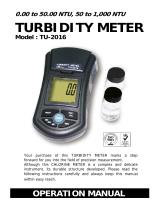
4.0 Instrument Calibration
The instrument was calibrated and tested prior to leaving the factory. Therefore, it is
possible to use the instrument directly out of the box. However, re-calibration of the
instrument is recommended to help you become familiar with the operation of the
instrument and the calibration procedures. In addition, re-calibration is recommended at
least once every three months.
The instrument requires four (4) standards to be fully calibrated.
During calibration, the instrument performs several system self-diagnostics. As such,
several warning messages may be displayed. If the instrument detects an irregularity
(detectors or lamp) a warning message will be displayed upon exiting the calibration
mode. If this occurs please attempt to rectify the problem yourself, or contact the
authorized technical services department (see section 5.2). In any event, the instrument
will continue to read the turbidity with a decreased accuracy until the error is rectified.
4.1 Calibration Standards
We recommend that you use the following materials
2
during calibration to achieve the
accuracy stated in this manual:
1. CAL 1: 1000 NTU
Calibration Standard available from HF scientific inc.
3
2. CAL 2: 100 NTU
Calibration Standard available from HF scientific inc.
3
3. CAL 3: 10.0 NTU
Calibration Standard available from HF scientific inc.
3
4. CAL 4: 0.02 NTU
Calibration Standard available from HF scientific inc.
3
It is well known that diluted Formazin is unstable. If you choose to use Formazin to
calibrate the instrument, ensure that you are using a fresh stock suspension of Formazin
to achieve the accuracy quoted for the instrument. A Formazin Stock Solution Kit is
available.
calibration standards are more stable than Formazin and have a
limited shelf life of 1 year. If you use the
calibration standards to calibrate the
instrument, review the expiration date to ensure that the standards have not expired.
calibration standards are a US EPA approved alternative standard to Formazin.
4.2 Indexing the Calibration Standards
The United States Environmental Protection Agency (US EPA) recommends that
cuvettes used for instrument calibration or sample measurement be indexed. To comply
with this recommendation, each calibration standard is supplied with an indexing ring
and each instrument has a reference point for quick and repeatable indexing of the
calibration standard. To index a calibration standard perform the following steps:
1. While holding down the
↵ button, slowly rotate the calibration standard one
complete revolution (360°) pausing between increments to allow the display to
update.
2
User prepared formazin may be used as an alternative to sealed calibration standards for calibration of this
instrument.
3
See section 7.0 for Accessories & Replacement Parts List.
Ref. 22666 (12/04)
Rev. 1.4
7




















